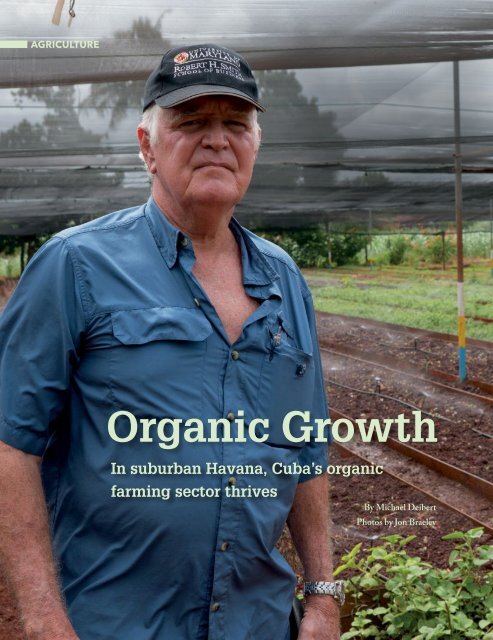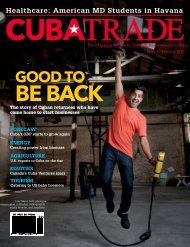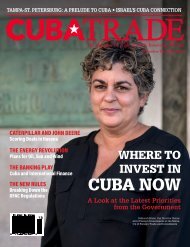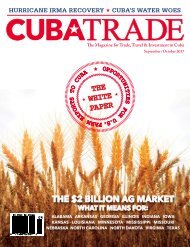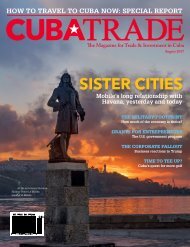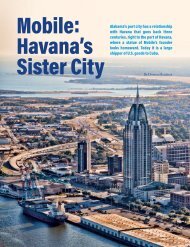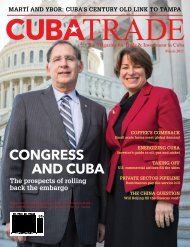CubaTrade-April2017-FLIPBOOK
Create successful ePaper yourself
Turn your PDF publications into a flip-book with our unique Google optimized e-Paper software.
AGRICULTURE<br />
Urban farming: The Alamar Organic Nursery, located in the Havana suburb of Alamar<br />
Organic Growth<br />
In suburban Havana, Cuba’s organic<br />
farming sector thrives<br />
By Michael Deibert<br />
Photos by Jon Braeley<br />
Dotted with stark Soviet-style apartment<br />
complexes built years ago to house workers<br />
and advisers from Cuba’s Cold War<br />
patrons, the Havana suburb of Alamar is<br />
better known as the birthplace of Cuban<br />
hip-hop than for any bucolic attributes.<br />
It is nonetheless a hotbed of the urban<br />
organic farming movement.<br />
Alamar is home to the Organoponico<br />
Vivero Alamar (The Alamar Organic<br />
Nursery), organized as a Unidad Básica<br />
de Producción Cooperativa (Basic Unit<br />
of Cooperative Production), a type of<br />
agricultural co-op in Cuba that has been<br />
instrumental in instigating the organic<br />
farming boom taking place on the island<br />
over the last 25 years. Borne out of necessity<br />
during the período especial (the “special<br />
period” in the early 1990s when subsidies<br />
from Cuba’s former patron the Soviet<br />
Union evaporated), the practice has now<br />
become a key component of the island’s<br />
drive towards economic self-sufficiency.<br />
“We have two goals with this enterprise,”<br />
says Miguel Angel Salcines Lópe,<br />
one of the farm’s founders, as he strolls<br />
along neatly-tended rows of mushrooms,<br />
brilliant green lettuce, and other vegetables.<br />
“The first is to supply food, to provide<br />
organic products at tolerable prices. The<br />
second is to create employment. Here<br />
there are 125 people working on 25 acres<br />
We have a lot of women and elderly<br />
people, who have a lot of knowledge and<br />
experience.”<br />
The devastation caused by the loss<br />
of Soviet support (the country’s Gross<br />
Domestic Product dropped by 34 percent)<br />
is what pushed Cuban agriculture<br />
from one dependent on fertilizer and<br />
diesel-powered machinery to one based on<br />
sustainable organic practices. At the same<br />
time, food rationing and a break down of<br />
distribution systems led to an explosion<br />
of urban agronomy. The result is that,<br />
according to Cuban government estimates,<br />
there are today some 10,000 organic urban<br />
farms in cities across the country.<br />
The Alamar Organic farm, founded<br />
at the end of the “special period” in 1997,<br />
started as a mere 8,000-square-foot plot.<br />
It now harvests 300 tons of vegetables annually.<br />
The farm also provides subsidized<br />
meals to workers, who toil 7 hours a day<br />
and are entitled to take 1.5 pounds of food<br />
home with them at the end of each shift.<br />
“I think what happened was there was<br />
already a group of scientists and certainly<br />
farmers who were seeing the negative impact<br />
of the highly intensive, industrialized<br />
agriculture system that Cuba had in the<br />
1980s,” says Margarita Fernandez, the Executive<br />
Director of the Burlington-based<br />
Vermont Caribbean Institute. “They were<br />
seeing a lot of negative impacts, and they<br />
were looking at the more holistic approach<br />
to grow food. The crisis allowed the political<br />
space for their vision to spread.”<br />
Organic farming—a type of farming<br />
APRIL 2017<br />
CUBATRADE<br />
47


